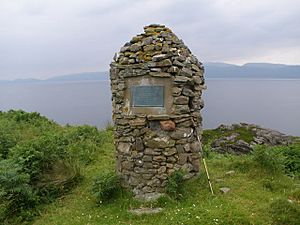Castle MacEwen facts for kids
Quick facts for kids Castle MacEwen |
|
|---|---|
| Scottish Gaelic: Caisteal Mhic Eoghainn | |
| Kilfinan, Argyll and Bute, Scotland | |

Monument on the site of Castle MacEwen
|
|
| Coordinates | 55°57′49″N 5°20′27″W / 55.963595°N 5.3408348°W |
| Type | Castle |
Castle MacEwen (which means Caisteal Mhic Eoghainn in Scottish Gaelic) is an old, ruined fort in Scotland. It's located on the east side of Loch Fyne, a long sea loch in Argyll and Bute. You can find it near a place called Kilfinan, about 5 kilometers (3 miles) south of Otter Ferry. This historic site tells us a lot about the people who lived here long ago.
A Look Back: Castle MacEwen's History
Castle MacEwen has a long and interesting past. The site was first home to an ancient type of fort called a dun. Later, it became a promontory fort, which is a fort built on a piece of land that sticks out into the water, making it easy to defend. Over time, it changed again into a medieval homestead, which was like a fortified farm or home.
This castle is strongly connected to the Clan MacEwen. This Scottish clan was known to live in the area around Loch Fyne. The castle was once owned by a group called the Clan Ewen of Otter.
In 1432, the chief of the clan, Swene MacEwen of Otter, gave his land to King James I. The King then made a special rule: if Swene died without a child to inherit, the land would go to Celestine Campbell. This is exactly what happened when Swene passed away in 1493. So, the castle and the lands around it became part of the Clan Campbell.
What Did Digs Reveal?
Archaeologists, who are like history detectives, did some exciting digs at Castle MacEwen in 1968 and 1969. They found that the very first structure on the site was a wooden fence enclosure from the medieval period. A fort was built right on top of this first structure.
Eventually, this fort was turned into a medieval homestead. The people who built the homestead used the old fort walls to make their defenses even stronger. They added large, rectangular stones to the existing walls. The archaeologists also found secret passages that led down to the sea on both the north and south sides!
They found Postholes, which are holes where wooden posts once stood. These posts were dated to the 15th and 16th centuries. They also discovered vitrified material, which is stone that has been melted and hardened by intense heat, often from a fire. This shows that parts of the fort might have been burned at some point.
In 1969, another cool discovery was made: a round house built right against the main wall near the entrance. This house had a floor made of small stones, like a cobblestone path. Experts think it might have been a storage building. They also found something that looked like a boat-shaped building just outside the main wall. However, they didn't find any objects inside these buildings, so it was hard to tell exactly how old they were.
Other amazing finds included a 12th-century crucifix, which is a cross with a figure of Jesus. They also found a 15th-century groat, which was a type of coin. Plus, pieces of pottery from the 13th and 18th centuries were uncovered. All these valuable finds were sent to the Glasgow Art Gallery and Museum for everyone to see and learn from.


